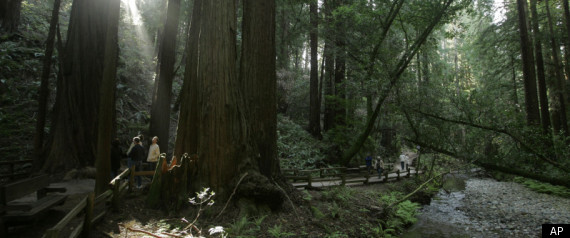SAN FRANCISCO -- Shuttering dozens of California state parks to trim
millions from the state budget will take more than simply hanging a
"Closed" sign on trailheads and beach parking lots. Many on the closure
list house thousands of historical treasures that must be packed up,
catalogued and stored if deals are not reached to save them.
The tens of thousands of items on public display paint a rich
portrait of California's past. Among them are rare crystalline gold
nuggets at the California Mining and Minerals Museum in Mariposa,
painting masterworks showing early 20th century San Francisco street
scenes and coastal landscapes at Shasta State Historical Park, and the
writer Jack London's home and writing memorabilia in Sonoma County.
California officials admit they have been overwhelmed by the
unprecedented move to close the parks, and just months before the
planned closures they are working to catalog these important pieces of
state history so they can undertake a massive packing, moving and
storage effort should a deal not be reached. And if the state does have
to move thousands of delicate items, it does not currently know how much
it will cost – or how much of its projected $22 million in savings it
will lose to pay for packing and long-term storage.
"When this started, I'm fairly sure we didn't have any exact science
on packaging and storage of artifacts. They knew there would be a cost,
but they weren't sure how to accurately estimate it," said Roy Stearns, a
spokesman for the California Department of Parks and Recreation.
California operates 278 parks on 1.3 million acres, each protecting
biological, historical or ecological resources, or in some cases all
three.
As the July 1 closure date approaches, officials are unsure how many
of the 70 parks on its closure list will remain open through
partnerships. Currently the parks department has inked deals with
nonprofits and other entities to keep 11 sites open, and 24 more parks
have early-stage negotiations in process that officials caution are no
sure thing.
Still, it's unclear how much savings are associated with individual
park closings because the state can't provide a breakdown of operating
costs for individual parks, according to a report issued in March by the
Legislative Analyst Office. The state also failed to consider in its
savings estimate the cost of packing, shipping and storing, the report
said.
"There are parks on the list where short-term savings will exceed the
cost of packing them up," Lia Moore, author of the report, told the
Associated Press.
According to the LAO report there are a number of cost-saving and
revenue generating ideas that the parks department has not implemented,
despite years of declining budgets, that could have helped keep more
parks from closing.
Some
of the ideas include charging entrance fees rather than parking fees to
deter visitors from leaving cars along roadways outside of parks and
hiking in to avoid paying. The analyst estimated that if just one in
eight people who visit parks paid to enter the state could reap "in the
low tens of millions of dollars annually."
"The argument is you limit access socioeconomically, but by closing
parks you're keeping people out of parks either way," Moore said.
The report also said reducing the need for the park system's 750
sworn peace officers by hiring staff at lower pay grades to guide tours
and interpret exhibits could save money.
"Those creative ideas aren't new to us," said Stearns. Yet he said
all of the ideas take time to implement and would not have helped save
money by the July 1 deadline.
"We looked at a budget situation where the straw had broken the
camel's back, and we could not afford to operate all the parks in system
at adequate levels," he said.
As it stands, park superintendents are scrambling to find partners to
fund and operate parks on the closure list before tackling the
overwhelming job of packing them up.
"The California State Mining and Mineral Museum Association is
working ... to keep it open and keep it there in Mariposa," said Kent
Gresham, the park's sector superintendent. "If that doesn't work out,
then as of July 1 we're going to have to pack up and relocate the
collection."
The minerals museum alone is home to more than 13,000 artifacts that
would cost more than $100,000 to pack and ship to storage, Gresham said.
The Shasta historical park houses another 23,000 items, including
more than 100 early 1900s urban and landscape paintings by famous
California artists such as Jules Pages, Maynard Dixon and Thaddeus Welch
collected and donated by the late suffragette and arts patron Mae
Helene Bacon Boggs.
"If she were alive this wouldn't be happening," said the park's sector superintendent Heidi Horvitz. "She was a real dynamo."
At nearby Weaverville Joss House State Historic Park, 6,780
individual Chinese artifacts and items will need to be packed and stored
at the state's longest operating Taoist temple if an agreement with a
nonprofit operator does not work out, Horvitz said. It will leave local
third graders without a destination for their California history field
trip, and the city of Weaverville without its downtown centerpiece.
Weaverville, Shasta and the mining museum are just three of the
nearly 25 parks on the closure list that contain a significant
collection of historical artifacts, according to a review of park
assets.
State curators are capable of packing them, said Blaine Lamb, the
head of the archaeology, history and museums division of the parks
department. But he could not estimate how much the effort would cost –
or if the costs would significantly eat into the $22 million the state
hopes to save by the closures.
"Our preference is to keep these artifacts as close to the parks, or
in the parks, as possible. Packing them up and moving them to storage in
Sacramento is our strategy of last resort," Lamb said.

No comments:
Post a Comment